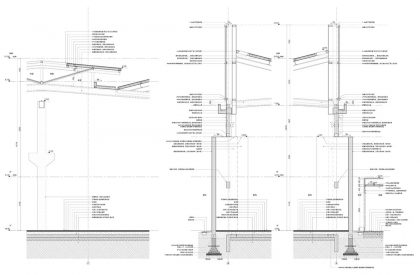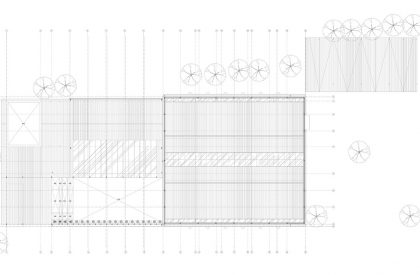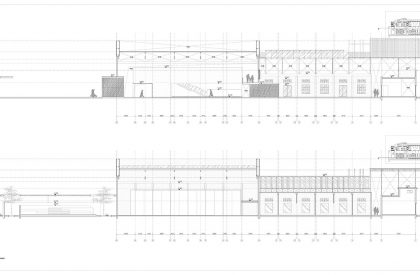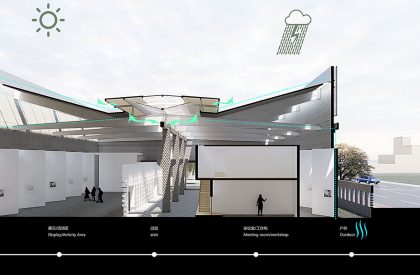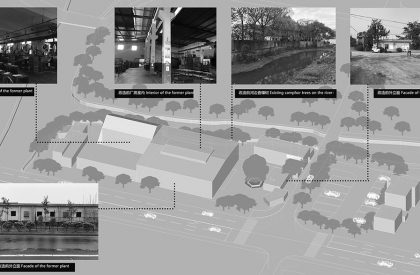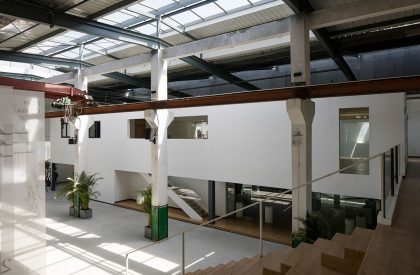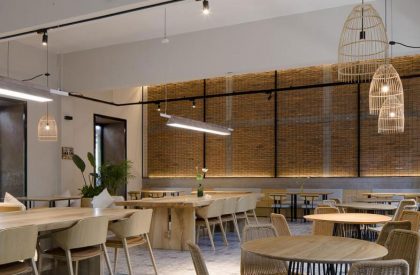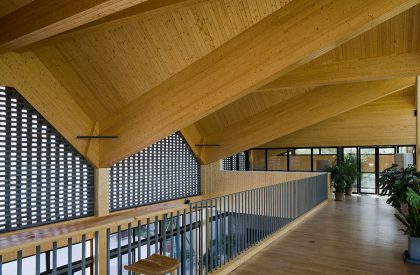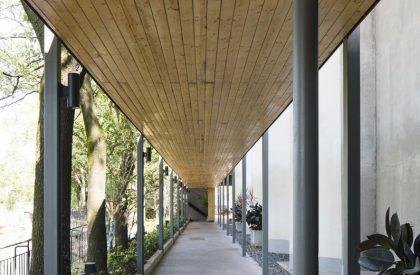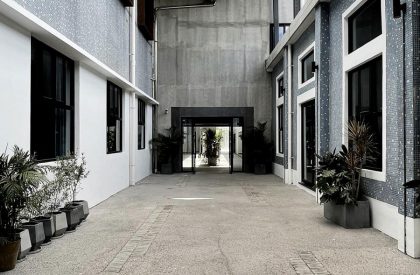Excerpt: Entrepreneurship & Innovation Center, designed by y.ad studio, is a multi-functional complex that aims to attract talents and promote rural revitalization and development. The design task of this project was to turn an old factory into Entrepreneurship & Innovation Center, making it an important destination for gatherings and cultural activities. For this project, we planned to retain the old textures of the existing walls, so as to form a contrast with the new folding display walls.
Project Description
[Text as submitted by architect]
1.Background
When entrusted with this plant transformation project, stereotypes of factory buildings pop into my head. But when arriving at the site, the buildings seemed a bit different from what I had imagined. The site used to be the heat treatment center of Yifeng Machinery Factory, a village-run enterprise. It consists of several buildings with a single-storey structure and steel roof, occupying a gross floor area of about 900m². Some of the workers were still on duty when we investigated the site. It was presumed that the plant was constructed in the late 1990s, but there was no drawing or material to prove that.
The material textures and appearance of the existing buildings featured the style of both 1990s and the present, which was a far cry from a space with a sense of history that I had imagined. There is a row of luxuriant camphor trees along the river beside. The site and the space were neither old enough nor new enough, which broke my original assumption and thus posed a great challenge to the design.



Dongbangtou Village, where the project sits, used to be an industrial village. Since the implementation of China’s Reform and Opening-up policy, Hardware Standard Parts Factory, Yifeng Machinery Factory, and Dongbao Silk Printing and Dyeing Factory had been set up here, along with a number of self-owned brands and high value-added, hi-tech enterprises in the late stage. Recently, the cultural & tourism project “Huashengbang Ideal Village” was launched here, which will promote both the change of Dongbangtou’s rural service mode and industrial structure, and its transformation from traditional industrial collective economy to the future rural community-oriented mode that attaches equal importance to industry and culture.
The design task of this project was to turn an old factory into Entrepreneurship & Innovation Center, making it an important destination for gatherings and cultural activities. The project will be a multi-functional complex that integrates the functions of display, cultural creation, leisure, cafe, and office, which is aimed to attract talents to come back home and entrepreneurs and tourists to go to the village, and promote rural revitalization and development.
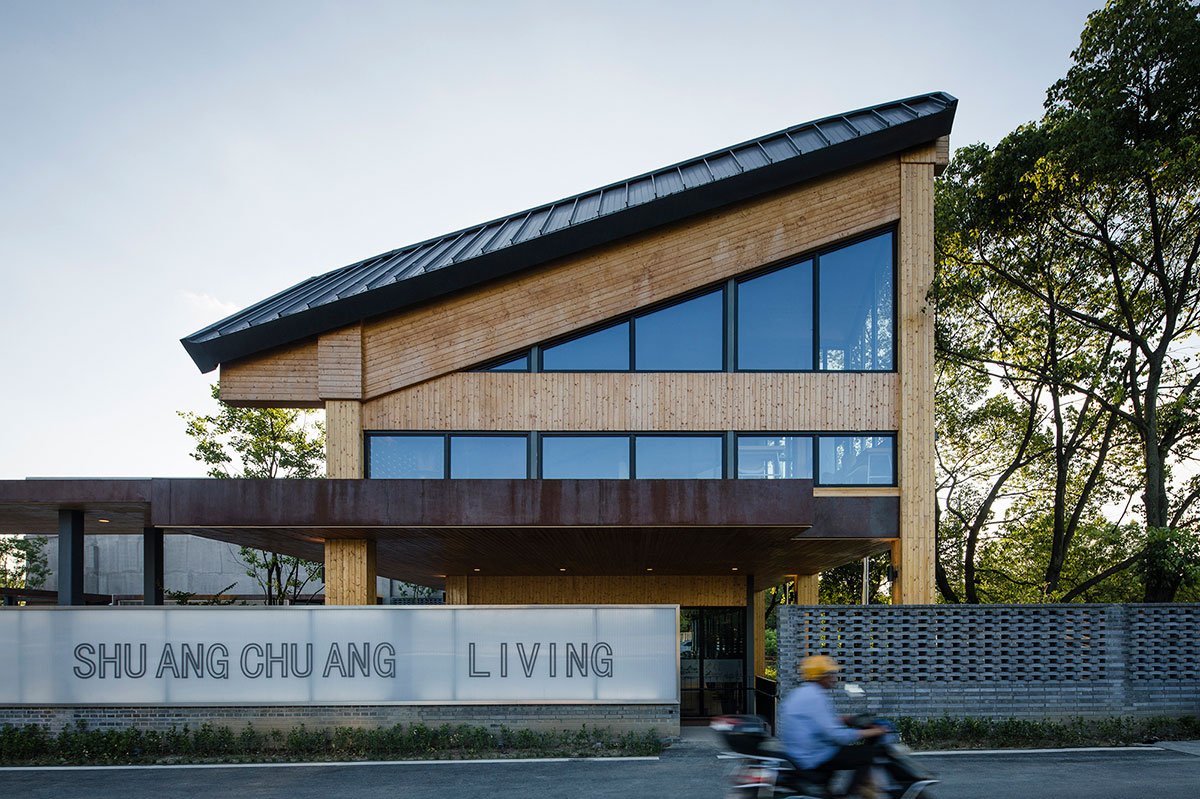


2.Functions and circulations
After reevaluating the existing building structures, we dismantled those buildings with unsafe structures, and retained the safe constructions for reinforcement and repurposing. We reorganized various functional areas based on demands. In addition to existing retained spaces, new ones were built to meet the needs of spatial use. Functional spaces are connected by a corridor, which not only forms different entry circulations, but also integrates the old and the new. In addition, an enclosed public activity square space is created in the front area to serve locals. A waterfront outdoor leisure area is set along the river.



3.Integration and reorganization of the old and the new
After demolition, it was difficult for the remaining retained buildings to become a whole. Through analysis, we stacked polycarbonate panels on the original walls in an enclosed manner to raise the overall height, so as to balance with the height of back buildings’ roofs. The added public washroom, the original kitchen and the cafe are covered by a continuous pitched tiled roof, together forming a whole. The newly built tourist center and the parking area outside continue the elements of triangular sloped roof, which echoes the existing constructions and creates a dialogue between the old and the new.
The original aging rooftop is replaced by raised polycarbonate panel walls. The two sides are lifted, and a skylight is set at the intersection of walls to bring in daylight. The original roof was demolished, and the glass skylight takes the place of original ventilation roof in the middle, so as to maximize the introduction of natural light. Two folding walls were inserted on both sides of the workshop area to increase the area of display wall for the future exhibition hall.



4.Material impression and past memory
The old and the new are integrated together. We hope that visitors can still experience the past memory of the original buildings. The green paint, blue mosaic exteriors and the tracks in original workshop showcase the distinctive memory of the 1990s. These elements are retained. To better blend the site into the environment, the camphor trees along the river are maintained, and the added corridor and window frames mainly adopt mottled weather-resistant steel.



5.Construction process
Reinforcing the existing building structures
Due to the aging walls and original irregular structures, we were faced with structural safety problems in the process of transformation. The connection between additions and existing walls is much more complicated than constructing a new building, which takes more time and cost. The height raising treatment by polycarbonate panel walls in the main plant workshop area also caused many problems. After demolition and on-site investigation, we found that the foundation of original walls was only 50cm deep, with no concrete beam structures under the ground. The original walls’ wind-resistance and load-bearing capacities were unable to support added steel structures on the roof. The steel columns cannot avoid existing walls to create an independent foundation under the ground.
After discussion, we adopted the most economical way to raise the columns, without changing original structures. Since the existing walls were fixed under the ground, reinforced concrete was added to the original brick columns, which integrated with old walls, thereby raising the building height.



Preserving old materials
We have been in an explosive era of constructing new buildings, and the public and construction workers are get used to it. When it comes to architectural refurbishment or transformation, most people may think of using new materials, sophisticated decoration craftsmanship and creating brand new scenes. Construction workers would doubt and have no idea what to do if we ask them to preserve the mottled wall coatings or rough textures, as they think that it may makes the building look like unfinished.
For this project, we planned to retain the old textures of the existing walls, so as to form a contrast with the new folding display walls. However, under the requirements of several relevant parties, the walls were eventually clad in new textured paint. As most people have be accustomed to exquisite building coatings and decorations, the fixed aesthetic taste and thinking make them hardly willing to accept the coexistence of the old and new. The intention that we wanted to preserve some old textures of the buildings is to create a contrast between the new and old, and to let the space to inherit past memories and show imperfect beauty.

